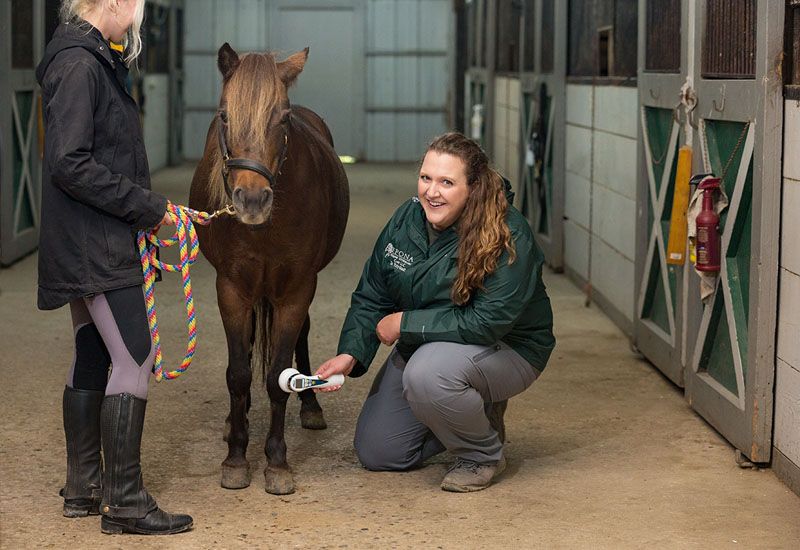Checking Out the Holistic Approach of Equine Therapy for Individual Growth
Checking Out the Holistic Approach of Equine Therapy for Individual Growth
Blog Article
How Laser Treatment in Horse Therapy Is Revolutionizing Veterinary Take Care Of Horses
Laser therapy has actually arised as a transformative approach in equine veterinary treatment, providing a non-invasive remedy that expedites healing and improves total wellness. The portability and flexibility of laser therapy gadgets additionally highlight their growing necessity among veterinarians.
Comprehending Laser Treatment

The innovation behind laser treatment is based in the principle of photochemistry, where photons are taken in by chromophores within cells, bring about increased ATP manufacturing and modulation of reactive oxygen varieties (Equine Therapy). This, subsequently, promotes mobile proliferation, lowers swelling, and accelerates recovery. Veterinary experts make use of different kinds of lasers, including low-level lasers (LLLT) and high-power Course IV lasers, relying on the details healing objectives and the nature of the equine condition being treated
Different laser wavelengths and power setups are thoroughly chosen to target different cells midsts and achieve preferred scientific results. Security procedures are paramount, as improper use can result in thermal damage or suboptimal therapeutic impacts. Therefore, a comprehensive understanding of laser therapy's devices and applications is essential for its reliable application in equine veterinary technique.
Benefits for Horse Wellness
The myriad advantages of laser treatment for equine health and wellness encompass enhanced recovery, pain reduction, and boosted mobility. This advanced therapy method leverages particular wavelengths of light to permeate tissues, promoting mobile feature and advertising rapid tissue repair work. The non-invasive nature of laser therapy ensures marginal stress and discomfort for the equine, facilitating a smoother healing process.
Improved recovery is among the leading benefits, as laser therapy speeds up mobile regeneration and collagen synthesis. This results in faster healing times from injuries and surgical treatments. Discomfort reduction is achieved with the anti-inflammatory impacts of laser treatment, which reduces swelling and reduces the manufacturing of pain-inducing chemicals. As an outcome, steeds experience substantial remedy for persistent and sharp pain conditions.
Enhanced wheelchair is another essential advantage, specifically for efficiency and functioning equines. By reducing swelling and pain, and boosting cells repair service, laser therapy assists in recovering joint function and muscle mass flexibility. The advancing effect of these benefits is not just a quicker return to normal task but likewise an overall enhancement in the horse's top quality of life. Therefore, laser therapy stands as a transformative tool in modern-day equine veterinary treatment.
Usual Problems Treated
Laser treatment has actually arised as a versatile treatment choice for a selection of common equine conditions. Amongst these, musculoskeletal injuries are especially open to laser therapy. Equine Therapy. Soft cells injuries, such as tendonitis and tendon pressures, benefit from the anti-inflammatory and analgesic effects of laser treatments, which accelerate healing and reduce discomfort. Additionally, laser therapy works for conditions like osteoarthritis, where it helps reduce joint inflammation and promote tissue repair service.
Wound administration is one more area where laser treatment has shown considerable guarantee. Chronic injuries or slow-healing abscess can be check my source particularly challenging in equines, yet laser therapy improves mobile regrowth and enhances blood circulation, thus speeding up the recovery process. Moreover, laser treatments have been effectively utilized in managing unguis problems such as laminitis and abscesses, relieving pain and advertising quicker recuperation.

Technology Behind Laser Treatment
Past the myriad problems treatable with laser therapy, the modern technology itself merits more detailed evaluation. At the heart of laser treatment is making use of particular wavelengths of light to pass through tissues and elicit organic reactions. These wavelengths, generally varying from 600 to 1000 nanometers, are precisely soaked up by chromophores in the skin, muscle mass, and various other tissues, initiating a waterfall of mobile events.
Laser gadgets utilized in veterinary medication commonly utilize low-level laser therapy (LLLT) or cool laser treatment. Unlike high-powered medical lasers, these gadgets run at lower energy redirected here levels, enhancing therapeutic benefits while lessening thermal damage. The energy from the laser light promotes click for info adenosine triphosphate (ATP) production, enhances cellular metabolic process, and accelerates cells fixing processes.

Success Stories and Situation Studies

Showcasing the substantial benefits of laser treatment, many success stories and study brighten its transformative influence on equine wellness. One such case entails a thoroughbred racehorse struggling with persistent tendonitis. Standard treatments produced minimal renovation, however after incorporating laser therapy into the program, the steed displayed substantial reductions in inflammation and pain within weeks, eventually going back to affordable auto racing.
Another engaging instance includes a dressage horse identified with extreme pain in the back, restricting its efficiency. A vet group utilized low-level laser treatment (LLLT) to target the irritated areas, leading to marked enhancement in adaptability and a notable reduction in discomfort. Over a number of sessions, the equine restored its peak type, showcasing the efficiency of laser therapy in attending to musculoskeletal concerns.
Furthermore, a research study carried out at a leading equine clinic analyzed 50 steeds with different soft tissue injuries treated with laser therapy. The results were striking: 85% of the steeds demonstrated increased recovery times and improved mobility. These situations underscore the adaptability and effectiveness of laser therapy in equine medication, using a non-invasive, scientifically-backed technique to improving healing and efficiency in horses.
Final Thought
Laser therapy is transforming equine veterinary care by giving a non-invasive therapy that accelerates healing, lowers swelling, and reduces discomfort. With its efficiency in dealing with a variety of conditions, from bone and joint injuries to persistent conditions like osteoarthritis, this modern technology substantially improves equine health and wellness and mobility. The mobility and adaptability of laser therapy better emphasize its transformative effect on vet methods, strengthening its function as an essential tool in contemporary equine medical care.
Report this page